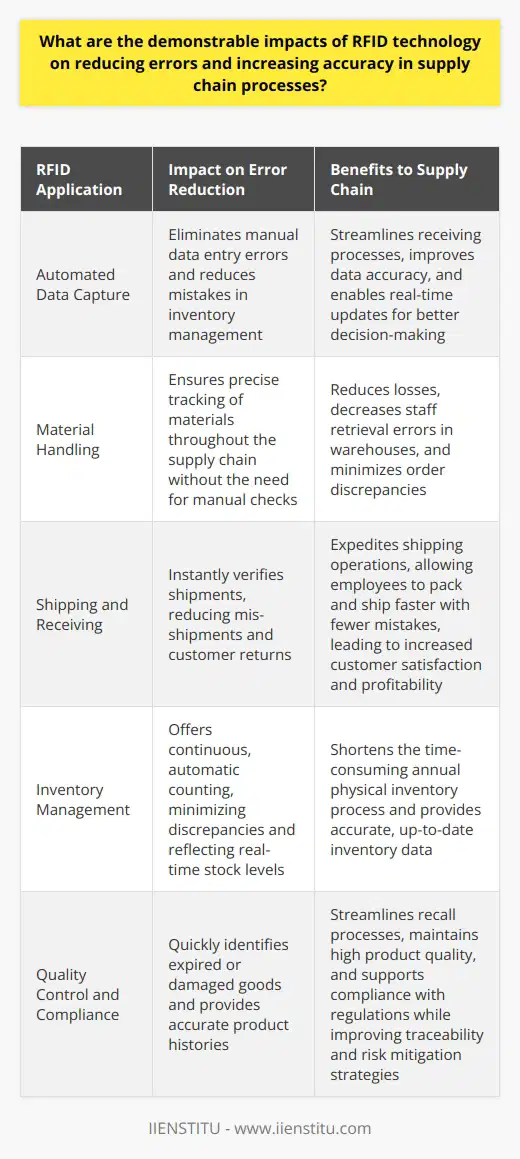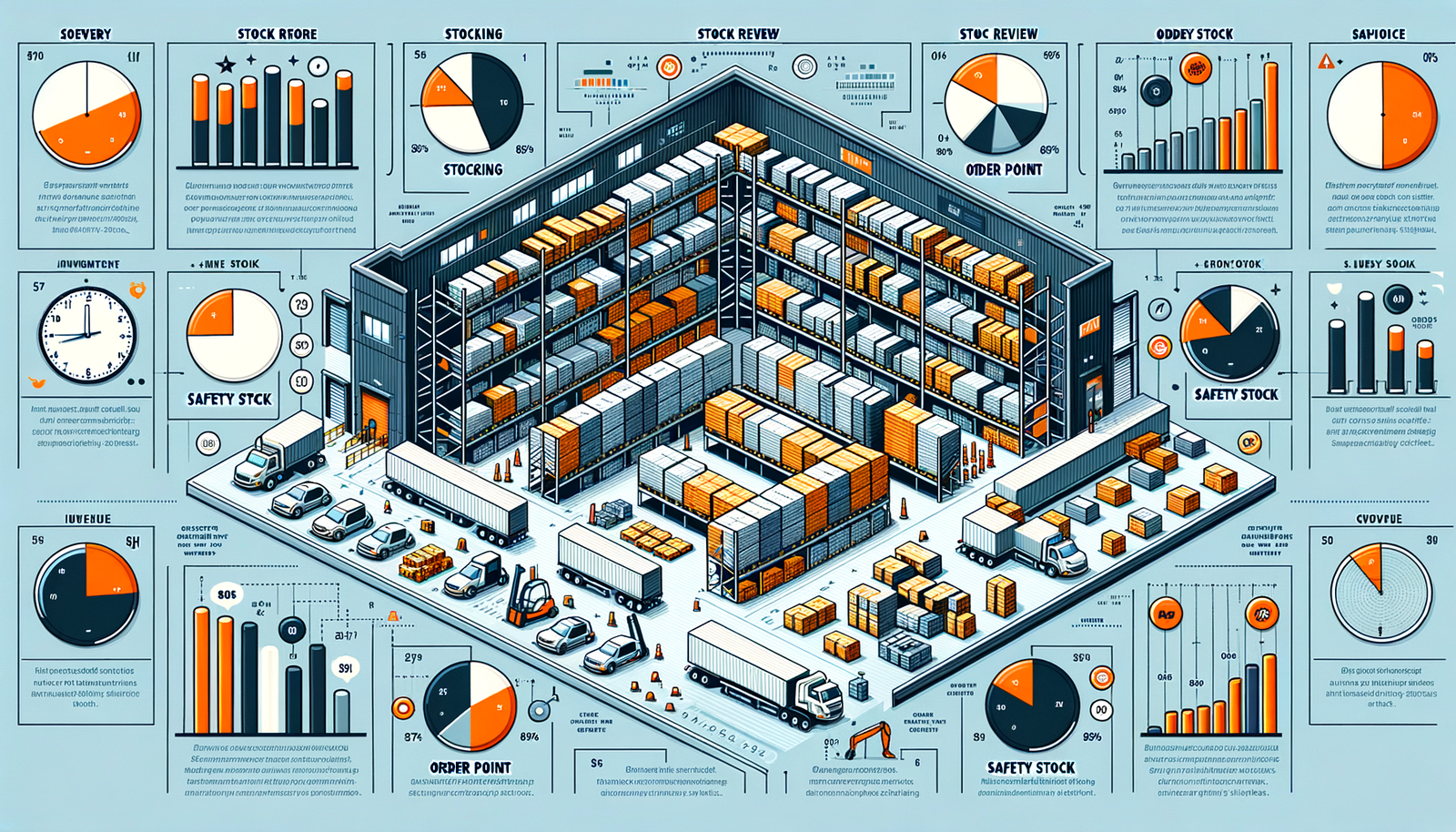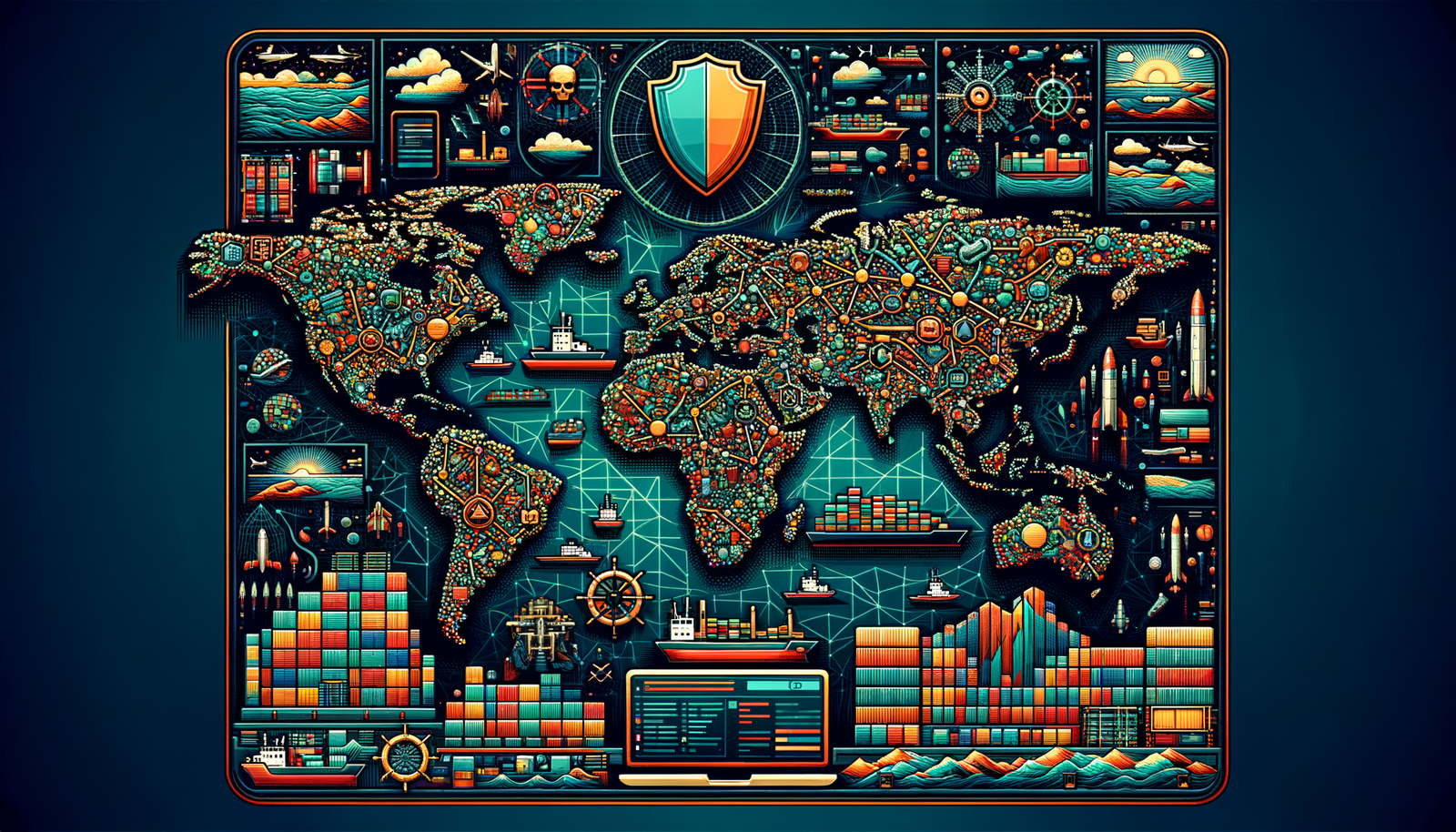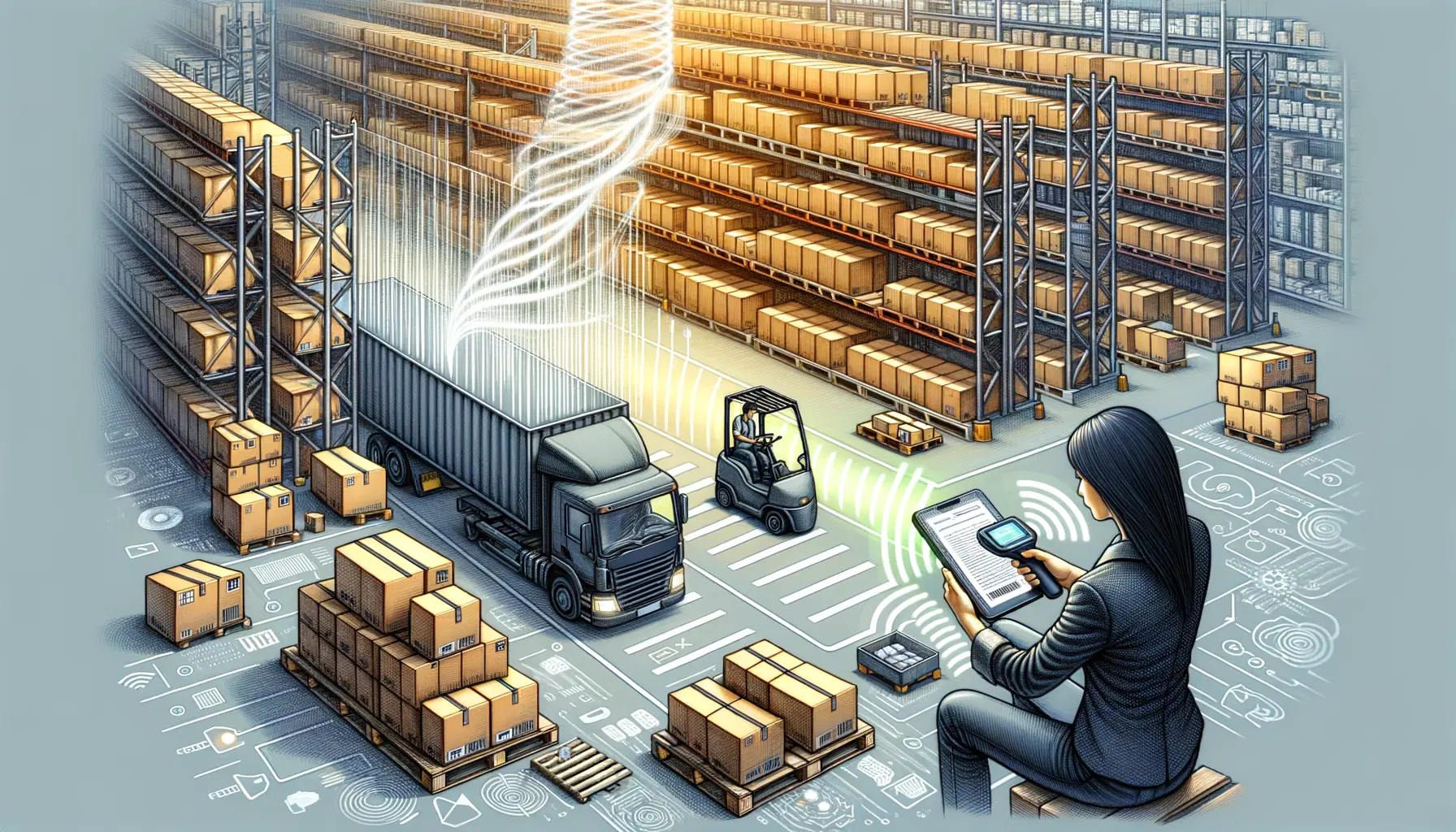
Radio-Frequency Identification (RFID) technology has revolutionized the way we track and manage items, from warehouse inventory to personal identification. It's a system composed of tags, readers, and an electronic infrastructure that allows for non-contact data transfer through radio-frequency electromagnetic fields. The origins of RFID can be traced back to the early 20th century, with significant advancements occurring during World War II. However, it wasn't until the late 1960s and early 1970s that RFID technology started to be commercialized and standardized.
I remember my first encounter with RFID technology during a visit to a large retail store. I was amazed at how quickly and efficiently the staff could track inventory and locate items using handheld RFID readers. It was a stark contrast to the manual counting and searching I had witnessed in smaller stores. This experience sparked my interest in learning more about the technology and its potential applications.
In today's fast-paced world, understanding and utilizing RFID can be the dividing line between efficiency and redundancy, lending a competitive edge to businesses that adopt it within their operations. As someone who has worked in supply chain management, I've seen firsthand how RFID implementation can streamline processes, reduce errors, and provide real-time data for informed decision-making.
How RFID Works
At its core, RFID works by attaching tags with electronic circuits and antennas to objects. These tags can store a wide range of information, from a simple identification number to comprehensive data about the item. The reader, or interrogator, emits a signal to activate the tag and read its data. This process allows for quick and accurate identification and tracking of items.
The components of an RFID system include:
RFID Tags: These are the data-carrying components that consist of a microchip and an antenna. Tags can be passive (powered by the reader's signal), active (with their own power source), or semi-passive.
RFID Readers: These devices communicate with tags via radio waves to read or write data. Readers can be fixed or portable and are designed to query RFID tags and capture data.
Antennas: Integral to both tags and readers, antennas enable the transmission of radio waves. Their shape, size, and type determine the read range and performance of the RFID system.
RFID systems operate at various frequencies, each with its own characteristics and applications:
Low-Frequency (LF) RFID: Operating at 125-134 kHz, LF RFID has a short read range and is less susceptible to interference from metals or liquids. It's often used for animal tagging and access control.
High-Frequency (HF) RFID: At 13.56 MHz, HF RFID offers a moderate read range and is commonly used for ticketing, payment systems, and data transfer applications.
Ultra-High Frequency (UHF) RFID: Operating between 856-960 MHz, UHF RFID provides the longest read range (up to several meters) and is well-suited for supply chain and logistics applications.
Applications of RFID Technology
Supply Chain Management
In my experience, the use of RFID in supply chain management has been a game-changer. By attaching RFID tags to products, businesses can track inventory levels, location, and movements in real-time. This visibility helps optimize stock management, reduce out-of-stocks, and improve responsiveness to market demands. For example, a warehouse equipped with RFID can quickly locate a specific pallet among thousands, saving time and labor costs.
Healthcare
RFID technology has also found meaningful applications in healthcare, enhancing patient care and asset management. Hospitals can use RFID wristbands to:
Track patient movements and manage care schedules
Ensure patients receive correct medications and treatments
Locate and manage medical equipment inventory
I once visited a hospital that had implemented RFID for patient tracking. The staff spoke highly of the system's ability to provide real-time location data, which improved patient safety and streamlined workflows.
Retail
In the retail industry, RFID offers benefits in inventory management, loss prevention, and customer experience. By tagging merchandise, retailers can:
Maintain accurate stock levels and reduce manual counting
Prevent theft and unauthorized removal of items
Enhance product availability and customer satisfaction
I've seen RFID-enabled smart shelves that automatically detect low stock levels and trigger replenishment alerts. This level of automation ensures that popular items are always available, leading to increased sales and customer loyalty.
Transportation
RFID has also found applications in transportation, from traffic management to toll collection. By embedding RFID tags in vehicles, authorities can monitor traffic patterns, manage congestion, and automate toll collection. This not only reduces traffic bottlenecks but also improves road safety and efficiency.
Advantages and Challenges of RFID
Like any technology, RFID has its pros and cons. The main advantages include:
Improved efficiency and accuracy in tracking and identification
Ability to read multiple tags simultaneously without line-of-sight
Real-time data capture and updates
Flexibility to read and write data on tags
However, there are also challenges to consider:
Higher upfront costs compared to traditional tracking systems
Potential interference issues in environments with metal or liquid
Concerns regarding privacy and data security
In my experience, the benefits of RFID often outweigh the challenges, especially when the system is well-designed and implemented with clear objectives in mind.
The Future of RFID
Looking ahead, the future of RFID is bright, with ongoing advancements and emerging applications. Researchers are working on increasing the capacity, range, and reliability of RFID systems while reducing costs. Innovations such as energy-harvesting tags and the integration of RFID with blockchain technology hold promise for further transformative impacts.
As the Internet of Things (IoT) continues to expand, RFID is poised to play a crucial role in connecting the physical and digital worlds. Potential new applications include:
Smart homes and cities
Environmental monitoring
Sports performance tracking and analytics
I'm excited to see how RFID technology will evolve and contribute to building a more connected, efficient, and sustainable future.
Conclusion
In conclusion, RFID technology has made significant strides since its inception, revolutionizing various industries through its ability to enable accurate and efficient tracking and data management. From supply chain optimization to healthcare improvements, RFID has demonstrated its value in enhancing operational efficiency, reducing costs, and unlocking new opportunities for innovation.
As we move towards an increasingly interconnected world, the role of RFID is set to expand further. By embracing this technology and understanding its potential, businesses and individuals alike can position themselves for success in the digital age.
Personally, I believe that learning about RFID and its applications is not only fascinating but also essential for professionals across industries. Whether you're a supply chain manager, healthcare administrator, or retail executive, having a grasp of RFID technology can help you make informed decisions, drive innovation, and stay ahead of the curve.
So, if you haven't already, I encourage you to explore the world of RFID and discover how it can benefit your organization or personal endeavors. The future is here, and it's powered by radio-frequency identification.
Frequently Asked Questions
What are the key contributions of RFID technology to the enhancement of supply chain efficiency?
Understanding RFID Technology
Radio-frequency identification (RFID) has revolutionized supply chains. It uses electromagnetic fields to automatically identify and track tags attached to objects. The tags store electronically-stored information.
How RFID Boosts Supply Chain Efficiency
Real-Time Data Capture
RFID provides instant data from tagged items. Supply chains gain immediate visibility. This reduces delays in information relay. It streamulates decision-making processes.
Inventory Accuracy
Inventory accuracy improves markedly with RFID. Traditional manual counts are prone to errors. RFID reduces these errors. This ensures stock levels remain precise.
Inventory Visibility
With RFID, inventory visibility reaches new heights. Managers monitor item location in real-time. They track goods through the entire supply chain. Such oversight enhances operational workflows.
Labor Reduction
RFID minimizes manual scanning requirements. Workers no longer perform repetitive barcode scans. This cuts labor costs and frees up resources. Employees focus on more strategic activities.
Asset Tracking
RFID enables comprehensive asset tracking. Firms use it to manage returnable assets. These assets include containers, pallets, and tools. Asset utilization rates improve as a result.
Reducing Shrinkage
Shrinkage represents a significant loss. RFID mitigates these losses effectively. It detects theft and misplacement early. Organizations use RFID to protect high-value goods.
Checkout Process Improvements
RFID speeds up the checkout process. This is true in both returnable assets and retail sales. Faster checkouts please customers and enhance throughput.
Counterfeit Prevention
The fight against counterfeit products leans on RFID. The technology secures the authenticity of goods. It deters the distribution of fake items in the supply chain.
Increasing Responsiveness
RFID information allows for faster response to demand changes. Supply chains adjust quickly to new patterns. Businesses stay ahead in a rapidly changing market.
Streamlining Recalls
Should a product recall occur, RFID aids in efficiency. Identifying and locating affected items takes less time. Companies manage recalls with reduced disruptions.
Enhancing Safety
Worker safety benefits from RFID. It tracks dangerous goods throughout the supply chain. This prevents accidents and enhances compliance.
Sustainable Practices
Businesses wishing to practice sustainability utilize RFID. It optimizes route planning and reduces waste. Sustainable approaches to supply chain management are vital.
Integration with Other Systems
RFID integrates with existing IT systems. It complements Warehouse Management Systems (WMS) and Transportation Management Systems (TMS). This creates synergies across the supply chain.
Conclusion
RFID offers substantial advantages. Supply chains gain efficiency, accuracy, and responsiveness. The technology's adoption continues to grow. It stands as a pillar of modern supply chain management.
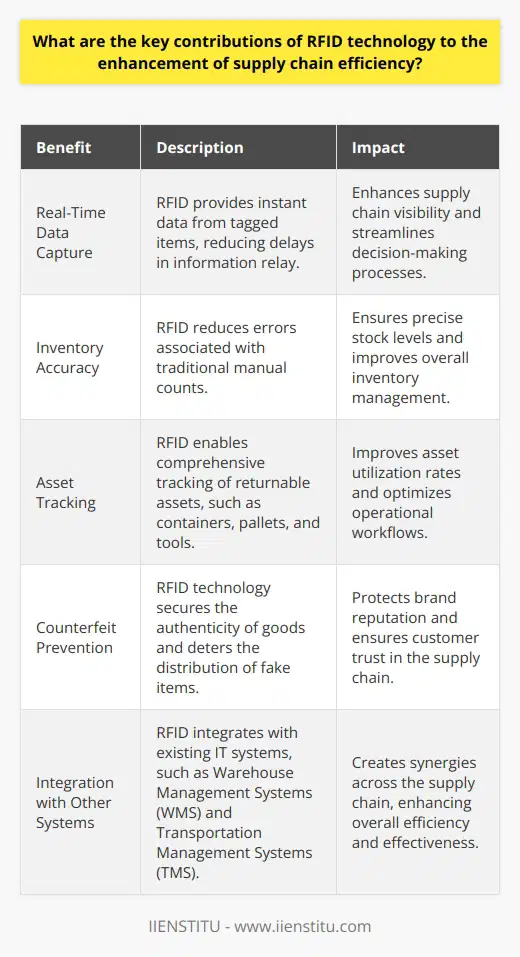
In what ways does RFID technology aid in inventory management and control within the supply chain?
Understanding RFID in Supply Chain Management
Radio Frequency Identification (RFID) technology revolutionizes how businesses handle inventory. It provides an efficient, accurate, and highly automated method of tracking items as they move through the supply chain.
Real-time Inventory Tracking
RFID tags store data about products. Tag readers scan them without a line of sight. This feature ensures that inventory levels are always up-to-date. Companies gain a real-time view of stock across multiple locations.
Enhanced Visibility
With RFID, visibility into inventory increases. Items are traceable at any supply chain stage. This transparency helps identify bottlenecks early. Firms can thus address potential issues swiftly.
Improved Accuracy
RFID minimizes human error in inventory counts. Traditional barcode scanning requires manual effort. RFID, however, scans multiple items simultaneously. This feature improves count accuracy significantly.
Streamlined Operations
Increased accuracy leads to streamlined operations. Fewer errors mean less time spent on recounts or reconciling inventory discrepancies. Workers can focus on more value-adding tasks.
Speed and Efficiency
RFID technology speeds up receiving, picking, and shipping processes. Workers scan items in bulk. This reduces the time products spend in receiving and distribution centers.
Inventory Optimization
Better data on inventory levels aids in optimization. Firms can reduce safety stock and lower carrying costs. Overstock and stockouts can decline. This optimization saves money and reduces waste.
Theft and Loss Reduction
RFID tags help with asset protection. They can trigger alarms if items move unexpectedly. Companies can thus reduce theft and misplacement losses.
Integration and Scalability
Data from RFID systems can integrate with Enterprise Resource Planning (ERP) systems. This integration enhances data analysis and decision-making. RFID solutions can scale to meet growing business needs.
Enhanced Customer Satisfaction
With better control over inventory, businesses can meet customer demands more efficiently. Accurate stock levels prevent delays and backorders. Prompt delivery can thus increase customer satisfaction and loyalty.
Overall, RFID technology plays a critical role in optimizing inventory management within the supply chain. It delivers accuracy, efficiency, and a competitive edge in today's fast-paced market. Businesses leveraging RFID stand to benefit from improved operations and increased customer satisfaction.
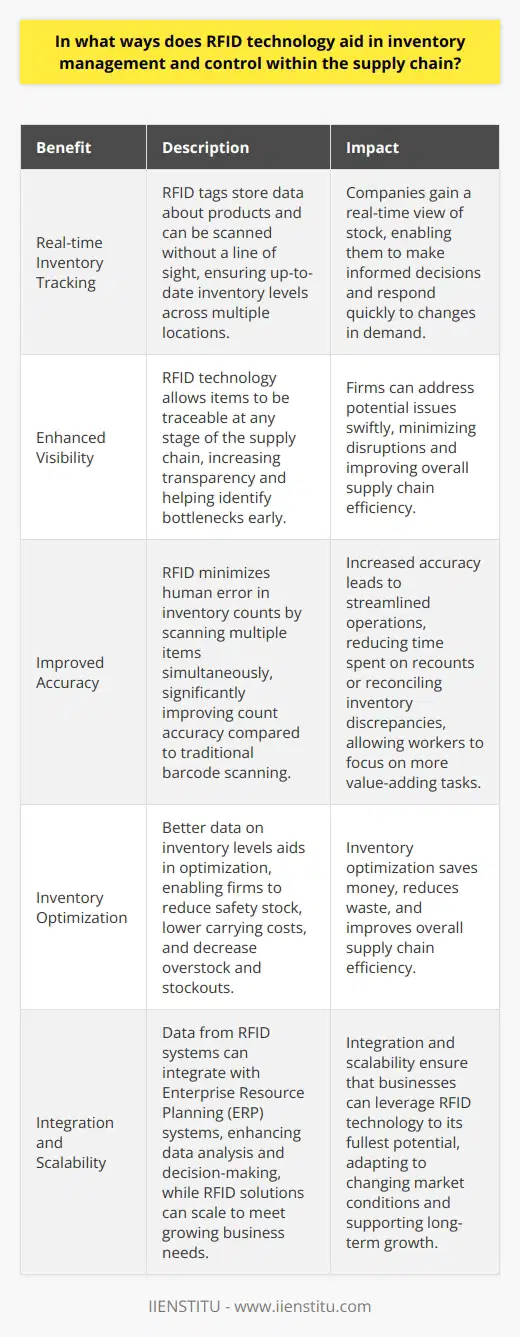
What are the demonstrable impacts of RFID technology on reducing errors and increasing accuracy in supply chain processes?
RFID Technology in Supply Chains
Introduction to RFID
Radio-frequency identification (RFID) offers efficient data capture. It transforms supply chain operations. Accuracy and speed define RFID benefits. Traditional barcoding falls short. RFID does not.
Error Reduction with RFID
RFID minimizes human error. Manual data entry leads to mistakes. RFID automates this. Mistakes plummet. Scanning barcodes requires line-of-sight. RFID does not. It reads multiple tags simultaneously. This reduces the errors significantly.
Inventory management sees vast improvements. Goods receive instant identification. This streamlines receiving processes. Employees can more easily verify inventory. Hence, fewer misplacements occur. Data accuracy increases. Real-time updates become the norm. Decision-making improves.
Enhanced Accuracy of Material Handling
RFID ensures precise material tracking. Equipment embeds RFID tags. It monitors materials through the supply chain. No manual checks are needed. Systems operate with high accuracy. They capture detailed product information. Item tracking becomes more accurate. Losses reduce.
Warehouse operations benefit immensely. RFID maps item locations. Staff retrieval errors decrease. Warehouse efficiency increases. Companies experience fewer order discrepancies. Customer satisfaction improves. Accuracy compels internal audits. These audits become simpler. RFID historical data supports these efforts. It ensures reliability.
Impact on Shipping and Receiving
Shipping and receiving processes improve. Receiving errors reduce drastically. Staff instantly verify shipments. Mis-shipments are few. Customer returns diminish.
RFID expedites shipping operations. Employees pack and ship faster. They make fewer mistakes. Customers receive the right products. Satisfaction grows. Profitability follows suit.
Automated RFID Advantages
Automation stands out with RFID. The technology reduces labor requirements. Costs go down. Employees focus on strategic tasks. Companies gain competitiveness. The supply chain becomes more resilient.
Inventory counts become seamless. Annual physical inventories consume time. RFID shortens this process. It offers continuous, automatic counting. Discrepancies are near nonexistent. Stock levels reflect real-time data.
Quality Control and Compliance
RFID enhances quality control. It identifies expired or damaged goods quickly. Recall processes streamline. Product quality remains high.
Compliance standards tighten. RFID supports compliance with regulations. It provides accurate product histories. Traceability improves. Risk mitigation strategies strengthen.
Conclusion
RFID technology marks a paradigm shift. It reduces errors and boosts accuracy. Supply chains evolve. They become more efficient, responsive, and reliable. RFID is the linchpin. It drives future supply chain innovation.
